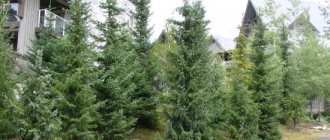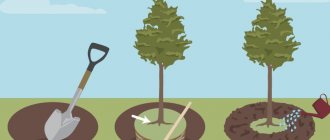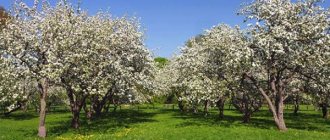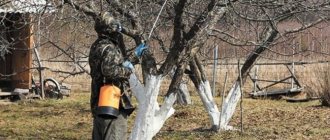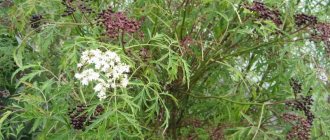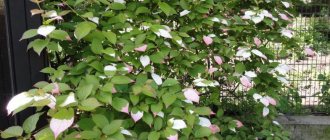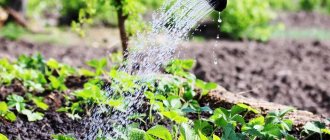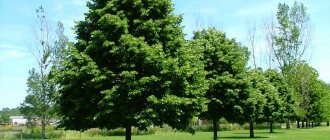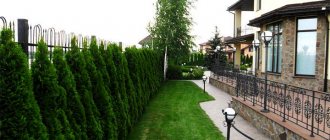Many summer residents dream of having their own garden with fruit trees, but they do not know that their dreams are easy to realize. The most important thing is to follow the recommendations of experienced gardeners, decide which fruit trees to plant on the site and pay attention to the quality of planting materials.
How to choose fruit trees for the garden
For each soil-climatic region or even region, it is worth selecting your own varieties of fruit-bearing woody plants suitable for seedlings. You should plant only proven varieties in your garden!
All varieties of pear and apple trees can be divided into 3 groups according to their ripening period:
- Summer varieties ripen the fastest, but the shelf life of the fruit is limited and after 12 hours they spoil.
- Autumn varieties ripen closer to autumn and are stored for almost 2 months.
- The fruits of winter varieties can last even until the new harvest.
When choosing fruit trees, keep in mind that many of their varieties produce a small harvest if their flowers are not pollinated by pollen from woody plants of another variety.
Therefore, it is necessary to plant trees of different varieties. In this regard, many plant growers know that in order to form a good harvest, for every 3 trees of one variety, you need to plant at least one woody plant of another variety - a pollinator. These fruit trees must bloom along with the pollinated ones. And in order for the process to be completed successfully, start hives with bees on the site.
When planting fruitful trees, take into account their resistance to cold. So, for example, the apple tree, especially the columnar type, is considered the most frost-resistant. Also, cherries are not afraid of frost; they grow well throughout the Russian Federation and rarely freeze. Pear, cherry plum and plum are heat-loving, but varieties of these trees with a columnar crown type grow successfully and bear fruit well in the harsh zones of Russia.
As for species such as apricot, peach, almond and cherry, these plants usually grow in the south. The only exceptions are Michurin apricot varieties, specially created for areas of risky farming.
Planning
Before planting a fruit garden, it is better to decide how to place trees and shrubs on the site. Having made sketches on paper, you can use your imagination to imagine how everything will look on the site.
There are two types of planning: landscape and regular. Perfectionists will enjoy a regular style garden plot because of the order. In it, woody plants and berry bushes are planted in even rows with identical intervals. The garden is divided in the form of regular rectangles and squares, separated by straight paths. With such an arrangement, it is easy to remember what is placed where, and it is easier to care for the plantings.
The best varieties for the Moscow region
Apple tree
- Summer (stored for no more than 2 weeks): Candy, Arkadik, Jubilee, Lungwort, Orlinka, Summer scarlet, White filling, Krasulya, July Chernenko, Lungwort, Melba, Jubilee.
- Autumn (storage - 1-3 months): Antonovka ordinary, Zhigulevskoe, Uspenskoe, Cinnamon striped, Solnyshko, Orlovskoe striped, Kurnakovskoe, Skala, Venyaminovskoe.
- Winter (stored for six months or more): Imrus, Veteran, Lobo, Orlik, Kulikovskoye, Northern Sinap, Bogatyr, Welsey, Orlovskaya Zarya, Charodeyka, Rozhdestvenskoye.
- Columnar-shaped (height - about 2 m, early-fruiting): Valyuta, Chervonets, Vasyugan, President, Malyukha.
Pear
- Summer (not stored): Lada, Cathedral, Severyanka, Chizhovskaya, Memory of Vavilov, Petrovskaya.
- Autumn (storage - no more than 1 month): Moskvichka, Veles, Memory of Yakovlev, Moscow Bergamot, Nadezhda, Belorusskaya late.
Cherry
Cherry
- Youth, Lyubskaya, Coeval, Rubinovaya, Crimson.
- Shokoladnitsa, Apukhtinskaya, Volochaevka, Voleka, Kentskaya.
- Vladimirskaya, Morozovka, Lotovaya, Tambovchanka, Shchedraya, Volzhskaya, Shakirovka.
Cherries
- Early ones: Iput, Early Sadko, Chermashnaya, Krasnaya Gorka, Ovstuzhenka.
- Mid-season: Fatezh, Teremoshka, Rechitsa.
- Late: Bryansk pink, Tyutchevka, Revna.
Cherevishnya
Fruit trees for the garden
Zhukovskaya, In Memory of Vavilov, Nurse, Strong, Miracle Cherry, Beauty of the North.
Plum
Skoroplodnaya, Blue gift, Eurasia-21, Egg blue, Morning, Opal, Zarechnaya early, Super early Egg blue, Blue gift, Smolinka, Hungarian Moscow, Morning, Smolinka, Alexy, Skorospelka red, Memory of Timiryazev, Victoria, Sineglazka, Yakhontovaya, Skoroplodnaya , Tula, Chinese.
Plum
Cherry plum
- Early – Gold of the Scythians, Kuban Comet, Traveler, Found, Tent.
- Late - Gift to St. Petersburg, Promen, Sigma, Krasnolistnaya TSKHA.
Apricot
Alyosha, Iceberg, Aquarius, Countess, Lel, Monastyrsky, Favorite, Alyosha, Iceberg, Lel, Tsarsky, Aquarius, Countess, Monastyrsky and Favorite.
Sea buckthorn
Vitamin, Early Yellow, Moscow Beauty, Amber, Pepper, Otradnenskaya, Trofimovskaya, Orange, Chuyskaya.
Black currant
Curiosity, Selechenskaya-2, Exotic, Dove Seedling, Otradnaya, Summer Resident, Nara, Belarusian, Perun, Dobrynya, Izyumnaya, Dubovskaya, Black Pearl, Necklace, Riddle, Fidelity, Venus, Vologda, Belarusian Sweet, Moscow, Izmailovskaya, Karelian, Detskoselskaya , Paulinka.
Currant
Honeysuckle
Zest, Bazhovskaya, Lapis Lazuli, Maria, Gorlinka, Lenita, Valentina,
Vasyuganskaya, Gerda, Sorceress, Blue Spindle, Long-fruited, Amazon, Blue Bird, Sorceress, Vitamin, Early, Nymph, Valentina, Dawn, Turtle Dove, Dessert, Chosen One, Fire Opal.
Fruit varieties for Siberia, the Urals, Leningrad region
Siberian gardeners have long adapted to growing good harvests of fruits and berries on their plots. Even the apricot and peach, previously considered exclusively southern crops, have found a place in northern gardens. The main thing is to choose the right variety and provide adequate care.
Suitable varieties for regions
| Culture | Siberia and the Urals | Leningrad region |
| Apple tree | · White filling – summer, frost-resistant variety. Has immunity to some diseases. Papirovka is a summer variety with good winter hardiness. It is better to form it in stale form. Resistant to diseases. Summer striped is an early ripening, self-sterile variety. Moderately frost-resistant. Antonovka - winter, persistent. Ripens in September. Melba and Welsey are varieties of foreign selection of early and medium maturity. | Wine, Papirovka, Friendship of Peoples, Auxis, Aelita, Chosen One, Autumn Striped, Melba, Cinnamon Striped, Antey, Druzhnoe, Antonovka vulgaris, Pepin saffron, Welsey, Asterisk, Renet Chernenko, Tellisaare. |
| Pear | Coral, Lel, Veles, Karataevskaya, Perun, Svarog, Dekabrinka, Autumn Dream, Lukashovka - all varieties are distinguished by good winter hardiness and good taste. | Bessemyanka, Tonkovetka. |
| Cherry | · Ob, Novoaltaiskaya, Metelitsa, Mayak - early ripening, self-sterile varieties. Ashinsky - self-fertile, buds can be damaged by frost. The Altai swallow is a good pollinator. | Vladimirskaya, Rubinovaya, Amorel Nikiforova. |
| Plum | · Altai Jubilee – early. Drooping - early variety, low tree. Very good winter hardiness. Pride of the Urals - self-fertile, disease resistant. Katunskaya, Nakhodka, Pionerka, Baikal Yantar are early, resistant varieties. | Hungarian Pulkovskaya, Skorospelka red, Skorospelka round, Renklod collective farm, Renklod Kuibyshevsky. |
| Black currant | · Memory Michurin, Rhapsody, Nina, Sibylla, Kent, Dashkovskaya - bred specifically for the Urals. Nara, Titania, Guliver - unpretentious, the ripened harvest lasts a long time on the branches. Hercules, Minusinka, Riddle, Lucia, Buraya, Gross - unpretentious frost-resistant varieties. | Belarusian sweet, Binar, White, Vologda, Volodinka, Detskoselskaya, Odzhebin, Orloviya, Poetry, Memory of Vavilov, St. Petersburg, Pilot Alexander Mamkin, Dove Seedling, Trilena, Ceres. |
| Honeysuckle | · Viola, Viliga, Cinderella, Blue Bird - early, resistant varieties. Amphora, Kamchadalka Bazhovskaya, Bakcharsky giant, Bakcharskaya, Bakcharskaya jubilee, Leningradsky giant are mid-season varieties. | Amphora, Volkhova, Morena, Nymph, Pavlovskaya, Tomichka, Violet. |
| Cherry plum | Mara, Traveler, Found, Gift to St. Petersburg, Columnar, Tent, Huck, Kuban Comet. | Gift to St. Petersburg |
Popular garden crops for growing in the country
Let's look at the most popular garden crops.
Zucchini . Planting zucchini in the garden is easy. In the first days of summer, when the threat of frost has passed (zucchini is a heat-loving species), plant the seeds in a bed protected from the winds and wait for a good harvest. However, you will also need to do weeding, loosening the soil layer, watering and a couple of fertilizing - and that’s it, you will have an excellent harvest.
Similar growing conditions are suitable for pumpkin . At the beginning of growing a vegetable crop, it is not only frost that poses a danger to it, but also birds. Twigs, hay, plastic bottles, netting, etc. will help you escape from them. After dense leaves appear, the shelter can be removed.
Peas . If you have a piece of land, for example, near a fence made of mesh or wood, then the best option is to place peas there. Peas belong to the vertical category, they require support, and fencing will save you from unnecessary hassle. It is better to start sowing peas in April so that the soil layer has time to completely warm up. Before planting, wet the seeds to improve germination and speed up the ripening process. The middle and even the end of the summer season is the time to start planting again. Most importantly, remember to be careful and attentive when working with garden crops.
Potato . The main problem when growing potatoes is the Colorado potato beetle. However, you can get rid of it, even without using chemicals. To do this, walk around your plantings every day and remove pests yourself into any container filled with soap or kerosene.
Otherwise, growing potatoes is not considered difficult. In addition to standard weeding, potato bushes need hilling. Thanks to this, the formation of tubers is activated, which means more yield.
Cucumbers . Of all the above crops, cucumbers are perhaps the most difficult to grow. However, even beginners cannot imagine their garden without this juicy vegetable, which is why we decided to add it to the list. When growing them, the following problems arise:
- illness;
- barren flowers;
- deterioration of taste;
- increased growth.
Low-growing perennials
Low-growing perennial shrubs usually include plants whose height does not exceed 1 meter. Various crops of low-growing perennials are usually used to form a beautiful background or to create hedges. In addition, low-growing shrubs will help reduce the number of weeds growing.
Low-growing perennial shrubs include:
- Common heather;
- Deytsia is graceful;
- Cotoneaster horizontal;
- Cinquefoil bush;
- Pachysandra apex is an evergreen, low-growing perennial shrub that grows quickly and is suitable for shady areas in the garden. The disadvantages of this plant are that it does not bloom for a long time in April;
- Japanese spirea (meadowsweet);
- Varieties of Barberry Thunberg: Edmiration (bush height 0.5 m, dark red leaves with a yellow border) and Bagatel (bush height 0.3 m; red-burgundy leaves);
- Hydrangea Nikko Blue (bush height 1 m);
- Dogwood, or Svidina blood-red Compress (bush height 0.8 m);
- Weigela blooming Bristol Ruby (bush height 60 cm);
- Buddleia Davida Blue Chip (bush height 1 m).
Rate this article:
Selection of planting material
The right choice of seeds for the garden is the key to an excellent harvest. Therefore, many seeds need to be purchased in special stores or branches. In most cases, only in such places do sellers have papers certifying the varietal and sowing characteristics of the material.
It is best to buy seed products from well-known companies. The varieties you buy must be included in the State Register. Also look at the expiration dates and the record of passing special control. The package must contain a lot of data: batch number, variety properties, assembly time, manufacturer contacts, etc.
Planting a fruit tree seedling in the ground
Detailed description of planting fruit woody plants in the ground:
- First make planting holes. For many trees, you will have to dig round holes with steep walls, 80 centimeters deep and 1 m in diameter. Apple and pear seedlings are planted in holes with a diameter of 1 m 25 cm, cherries - 90-100, but for cherries and plums 80 is enough.
- Experienced plant growers recommend driving a stake for the seedling in the center of the hole. Because when driving it in after planting, the roots can be seriously damaged. And this will lead to the death of your vegetation in the garden or vegetable garden.
- While forming the hole, set aside the top soil layer one piece at a time, then it will be needed to fill the hole. Fill the formed hole with soil that was previously mixed with fertilizers that are needed for complete replenishment.
- Mix the remaining soil layer with sand, turf and peat mixture, then fill the hole with this.
- It is best not to plant a tree alone; involve a friend or loved one in this interesting activity. In this case, one will hold the plant, and the other will fill the hole.
- Lower the desired seedling into the planting hole, straighten the roots completely and make sure that the main root is located vertically.
- Fill the free space between the roots with a layer of soil and compact the soil.
- Some woody fruit plants will need to be deepened so that the root collar is located high, 6 cm above the surface.
- After digging, form a mini-mound on the surface of the hole for subsequent shrinkage of the soil.
- It is also worth forming a roller around the trunk so that during the watering process the liquid is retained in the hole and absorbed by the roots.
- After placing the seedling, water it with water. The required quantity is 2-3 buckets.
Decide which trees to plant in the garden, and it’s easy to care for them if you have free time. Lovers of beautiful landscapes can create an ornamental garden using fruit woody plants and berry bushes, placing them with ornamental plants, perennial flowers and conifers.
Shade-loving perennials
Every piece of land should be of benefit to the gardener or gardener; either something useful or something beautiful and pleasing to the eye should grow everywhere. The problematic point in bringing this idea to life are dark places. For such areas, you can select shrubs or vegetables that can grow in partial shade or shade.
Shade-loving berry perennial shrubs include:
- Currant;
- Yoshta;
- Blueberry;
- Raspberries;
- Blackberry;
- Dogwood.
Shade-loving ornamental perennial shrubs include:
- Hydrangea paniculata. The plant can grow in shady areas, although it blooms less in such conditions.
- Rhododendrons These shade-loving shrubs prefer partial shade and even shade. They bloom beautifully in May and early June. Rhododendrons need loose sandy-humus and acidic soil with moderate moisture.
